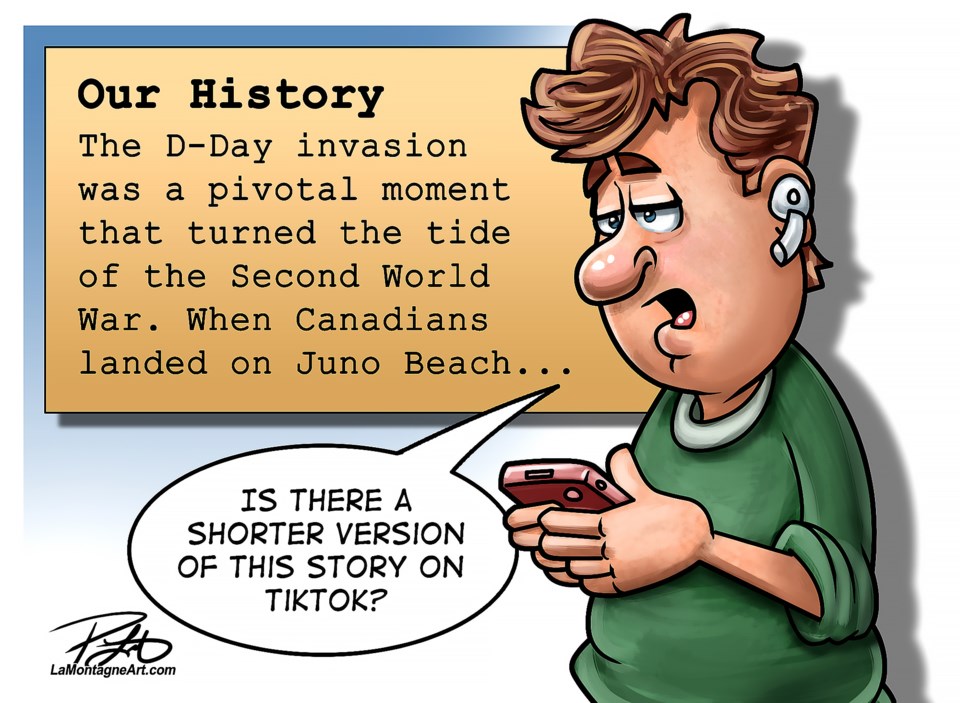Canada’s involvement in the Second World War is among the pinnacle moments in the country’s history.
And with the 80th anniversary of the June 6, 1944, Normandy landings – commonly referred to as D-Day – taking place, how do we remember, commemorate and recognize the moment?
Pivotal anniversaries are regularly recognized in five- or 10-year intervals, meaning it will likely be the final major ceremony with living veterans attending.
Fifteen Canadian veterans will be in Normandy this year – the youngest being 98 and the oldest 104 – while the British government is sending 40 and about 150 American Second World War veterans are going, highlighting the dwindling number remaining.
As veterans pass away, history and its memory can often fade into the background as the moments become more distant and few who experienced it in real-time left.
Across the world, history is remembered daily despite generations having come and gone, but when those who lived through it pass away it can take on a different form of meaning.
For decades, memorializing the Normandy invasions and the war itself was largely non-existent.
Unlike the First World War, which saw immediate commemoration, the Second World War was out-of-sight, out-of-mind. Not until the 1980s did large-scale remembrance begin taking place and growing.
The invasion itself was a monumental show of force and displayed the massive capability of the western Allied military’s ability to put together an utterly impressive show of logistics in not only bringing it all together, but also making the staggering show of firepower work.
From Courseulles-sur-Mer and Bernières-sur-Mer and Saint-Aubin-sur-Mer and Langrune-sur-Mer, Juno Beach was one of five beaches stretching about 75 kilometres.
Though the vaunted western wall along the French coast was largely nothing more than scattered pillboxes and largely ill-trained soldiers, within weeks the remaining strongest units of the German army had mostly been deployed in France.
On D-Day, Canadians made up 14,000 of the roughly 150,000 Allied soldiers who landed or parachuted into France. A total of 1,074 Canadians were casualties, including 359 killed.
By the end of the campaign in late August, which saw the German army routed and withdrawing faster than Allied forces could chase them, more than 18,700 Canadians had been casualties, including more than 5,000 killed, with Allied armies suffering more than 200,000 casualties.
Many of those are buried at the Canadian war cemetery at Bény-sur-Mer, only kilometres from the French coast.
At a time when Canada’s population was 11.5 million people, roughly 1.1 million served in a branch of the Canadian Armed Forces. Of those, 45,400 were killed and a further 55,000 wounded.
Though 80 per cent served only in Canada, the country sent soldiers to all corners of the world in the six years of what remains the largest military action in human history. From battlefields in Italy, Hong Kong, North Africa, and France to the Battle of the Atlantic and the skies over Europe to training and garrison duty across Asia, Australia and the Pacific, the war remains an aspect that defines Canada.
Though becoming further distant by the year, the Normandy invasion remains a part of the political ideology of many western countries. It can regularly become a comparison of democracy triumphing over dictators, leading to an oversimplification of a drastically complex and difficult matter.
The war reshaped Europe’s ethnic map – largely still existing today – leading to millions of people being shifted across the continent and beyond.
The invasion served as the turning point of the war in western Europe and continues to be used as a pillar to better understand the present times in juxtaposition of historical memory.
It’s often used to better understand or explain events of the world of today, but the present time is far different than the world of the 1940s.
Undoubtedly during ceremonies, the past will be used to connect to the present.
For many of history’s key moments, it’s OK to simply remember and recognize the past rather than use it to explain both the present and future.




